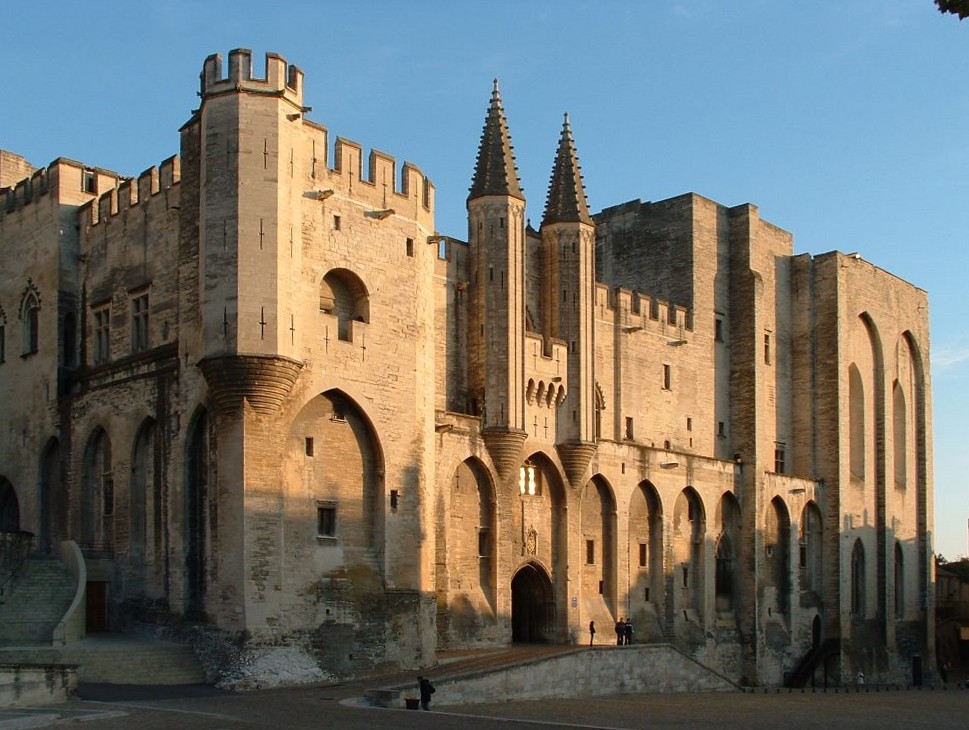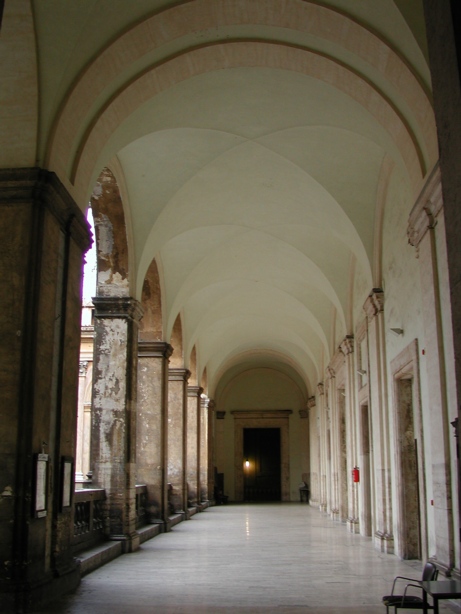|
Olimpia Maidalchini
Olimpia Maidalchini Pamphilj (26 May 1591 – 27 September 1657), (also spelled Pamphili and known as Olimpia Pamphili), was the sister-in-law of Pope Innocent X (Pamphili). She was perceived by her contemporaries as having influence regarding papal appointments. She is not to be confused with her daughter-in-law Olimpia Aldobrandini, who married her son Camillo. Early life Maidalchini was born in Viterbo, the eldest of three daughters of Sforza Maidalchini, a condottiere, and Vittoria Gualterio, patrician of Orvieto and Rome. Vittoria was a noble of Viterbo, the daughter of Giulio Gualterio (who was the son of Sebastiano Gualterio, Bishop of Viterbo, and Papal Nuncio to France and the Council of Trent). Her family was only moderately wealthy. In order to conserve the family property for his only son, Sforza Maidalchini decided that his daughters should enter religious life, where the dowry to enter a convent was less than that required for a suitable marriage. Olimpia refused, ... [...More Info...] [...Related Items...] OR: [Wikipedia] [Google] [Baidu] |
Diego Velázquez
Diego Rodríguez de Silva y Velázquez (baptized June 6, 1599August 6, 1660) was a Spanish painter, the leading artist in the court of King Philip IV of Spain and Portugal, and of the Spanish Golden Age. He was an individualistic artist of the Baroque period (c.1600–1750). He began to paint in a precise tenebrist style, later developing a freer manner characterized by bold brushwork. In addition to numerous renditions of scenes of historical and cultural significance, he painted scores of portraits of the Spanish royal family and commoners, culminating in his masterpiece ''Las Meninas'' (1656). Velázquez's paintings became a model for 19th-century realist and impressionist painters. In the 20th century, artists such as Pablo Picasso, Salvador Dalí, and Francis Bacon paid tribute to Velázquez by re-interpreting some of his most iconic images. Most of his work entered the Spanish royal collection, and by far the best collection is in the Museo del Prado in Madrid, thoug ... [...More Info...] [...Related Items...] OR: [Wikipedia] [Google] [Baidu] |
Cardinal-nephew
A cardinal-nephew ( la, cardinalis nepos; it, cardinale nipote; es, valido de su tío; pt, cardeal-sobrinho; french: prince de fortune)Signorotto and Visceglia, 2002, p. 114. Modern French scholarly literature uses the term "cardinal-neveu'". was a cardinal elevated by a pope who was that cardinal's relative. The practice of creating cardinal-nephews originated in the Middle Ages, and reached its apex during the 16th and 17th centuries. The last cardinal-nephew was named in 1689 and the practice was abolished in 1692.Bunson, Matthew. 1995.Cardinal Nephew. ''The Pope Encyclopedia''. Crown Trade Paperbacks. . The word ''nepotism'' originally referred specifically to this practice, when it appeared in the English language about 1669. From the middle of the Avignon Papacy (1309–1377) until Pope Innocent XII's anti-nepotism bull (a papal charter), ''Romanum decet pontificem'' (1692), a pope without a cardinal-nephew was the exception to the rule. Every Renaissance pope who creat ... [...More Info...] [...Related Items...] OR: [Wikipedia] [Google] [Baidu] |
Cardinal-Nephew
A cardinal-nephew ( la, cardinalis nepos; it, cardinale nipote; es, valido de su tío; pt, cardeal-sobrinho; french: prince de fortune)Signorotto and Visceglia, 2002, p. 114. Modern French scholarly literature uses the term "cardinal-neveu'". was a cardinal elevated by a pope who was that cardinal's relative. The practice of creating cardinal-nephews originated in the Middle Ages, and reached its apex during the 16th and 17th centuries. The last cardinal-nephew was named in 1689 and the practice was abolished in 1692.Bunson, Matthew. 1995.Cardinal Nephew. ''The Pope Encyclopedia''. Crown Trade Paperbacks. . The word ''nepotism'' originally referred specifically to this practice, when it appeared in the English language about 1669. From the middle of the Avignon Papacy (1309–1377) until Pope Innocent XII's anti-nepotism bull (a papal charter), ''Romanum decet pontificem'' (1692), a pope without a cardinal-nephew was the exception to the rule. Every Renaissance pope who creat ... [...More Info...] [...Related Items...] OR: [Wikipedia] [Google] [Baidu] |
James Craigie Robertson
James Craigie Robertson (1813 – 9 July 1882) was a Scottish Anglican churchman, canon of Canterbury Cathedral, and author of a ''History of the Christian Church''. Life Robertson was born at Aberdeen, where his father was a merchant; his mother's maiden name was Craigie. His early education was mainly at Udny Academy, but he is said to have been at twelve other schools. His father was a Presbyterian, but his mother's family was Episcopalian. Robertson studied for a time for the Scottish bar, but having decided on ordination in the Church of England, he entered Trinity College, Cambridge in 1831, and graduated B.A. in 1834, and M.A. in 1838. He did not attempt to take honours, but spent vacations in Germany, and studied German literature. He was ordained in 1836. After serving two curacies, Robertson was instituted in 1846 to the vicarage of Bekesbourne, near Canterbury. There he concentrated on historical research. In 1859 he was made canon of Canterbury, and from 1864 to 1874 ... [...More Info...] [...Related Items...] OR: [Wikipedia] [Google] [Baidu] |
John Bargrave
John Bargrave (1610 – 11 May 1680), was an English author and collector and a canon of Canterbury Cathedral.''Under the Sign: John Bargrave as Collector, Traveler, and Witness'' by Stephen Bann, Michigan, 1995 Early life Bargrave was born in Kent in 1610, the son of Captain John Bargrave and Jane Crouch. His father had fought in the war between the English and the Spanish and had returned to Bridge to raise a family. The Bargraves had recently come to be considered local gentry and this had resulted in the marriage of Bargrave Snr. and the daughter of London haberdasher, Giles Crouch, who later built and impressive family home known as ''Bifrons'' at nearby Patrixbourne.The Bargrave Collection by |
Roman College
The Roman College ( la, Collegium Romanum, it, Collegio Romano) was a school established by St. Ignatius of Loyola in 1551, just 11 years after he founded the Society of Jesus (Jesuits). It quickly grew to include classes from elementary school through university level and moved to several successive locations to accommodate its burgeoning student population. With the patronage of Pope Gregory XIII, the final seat of the Roman College was built in 1584 near the center of Rome's most historic Pigna district, on what today is called Piazza del Collegio Romano, adding the church of St. Ignatius in 1626, and a renowned observatory in 1787. The college remained at this location for 286 years until the revolutionary Capture of Rome in 1870.In 1870, the new Italian government confiscated the property of the university and their building (that eventually became the Ennio Quirino Visconti Liceo Ginnasio), which forced the university to transfer to the Palazzo Gabrielli-Borromeo on the ... [...More Info...] [...Related Items...] OR: [Wikipedia] [Google] [Baidu] |
Camillo Astalli
Camillo Astalli (21 October 1616 – 21 December 1663) was an Italian Catholic Cardinal and Cardinal-Nephew of Pope Innocent X who served as Cardinal Priest of San Pietro in Montorio (1653–1662), Camerlengo of the Sacred College of Cardinals (1661–1662), and Archbishop (personal title) of Catania (1661–1663)."Camillo Cardinal Astalli-Pamphilj" ''''. David M. Cheney. Retrieved September 19, 2016 Early life Camillo Astalli belonged to a noble but relatively poor family. He was born in Sambuci, at Tivoli, 21 October 1616 to Fulvio and Catherine Pinelli Astalli. He studied at the |
Francesco Maidalchini
Francesco Maidalchini (21 April 1631 – 13 June 1700) was an Italian Cardinal of the Roman Catholic Church. Early life Maidalchini was born 12 April 1631 in Viterbo, the son of Andrea Maidalchini and Pacifica Feliziani. His father was the brother of Olimpia Maidalchini; sister-in-law of Pope Innocent X. Anti-Catholic publicist Gregorio Leti described Francesco Maidalchini as a person "with no experience in the things of the world, ignorant in letters and incapable of learning". He was named commendatory abbot of St. Martin and St. Gaudentius of Rimini and San Pancrazio outside the walls of Rome. He also received the title of Canon of St. Peter's Basilica in Rome. Cardinal-nephew In 1647, Maidalchini's first cousin, Camillo Francesco Maria Pamphili, resigned his post as Cardinal-Nephew to marry and Innocent X required a new Cardinal Nephew. Without any remaining male relative to turn to for an assistant, Innocent X was persuaded to appointed the seventeen-year-old Francesco ... [...More Info...] [...Related Items...] OR: [Wikipedia] [Google] [Baidu] |
Paolo Borghese (1622-1646)
Paolo Borghese may refer to: *Paolo Borghese (1622–1646) Paolo Borghese (1622/24–1646) was an Italian nobleman of the Borghese family. He was the son of Marcantonio II Borghese (1598–1658) and his wife Camilla Orsini. Paolo was the first husband of Olimpia Aldobrandini, whom he married in 1638. The ..., Italian nobleman, first husband of Olimpia Aldobrandini *Prince Paolo Borghese (1904-1985), Italian nobleman {{DEFAULTSORT:Borghese, Paolo ... [...More Info...] [...Related Items...] OR: [Wikipedia] [Google] [Baidu] |
Pope Clement VIII
Pope Clement VIII ( la, Clemens VIII; it, Clemente VIII; 24 February 1536 – 3 March 1605), born Ippolito Aldobrandini, was head of the Catholic Church and ruler of the Papal States from 2 February 1592 to his death in March 1605. Born in Fano, Italy to a prominent Florentine family, he initially came to prominence as a canon lawyer before being made a Cardinal-Priest in 1585. In 1592 he was elected Pope and took the name of Clement. During his papacy he effected the reconciliation of Henry IV of France to the Catholic faith and was instrumental in setting up an alliance of Christian nations to oppose the Ottoman Empire in the so-called Long War. He also successfully adjudicated in a bitter dispute between the Dominicans and the Jesuits on the issue of efficacious grace and free will. In 1600 he presided over a jubilee which saw many pilgrimages to Rome. He presided over the trial and execution of Giordano Bruno and implementing strict measures against Jewish residen ... [...More Info...] [...Related Items...] OR: [Wikipedia] [Google] [Baidu] |
Barberini Family
The House of Barberini are a family of the Italian nobility that rose to prominence in 17th century Rome. Their influence peaked with the election of Cardinal Maffeo Barberini to the papal throne in 1623, as Pope Urban VIII. Their urban palace, the Palazzo Barberini, completed in 1633 by Bernini, today houses Italy's Galleria Nazionale d'Arte Antica (National Gallery of Ancient Art). Early history The Barberini family were originally a family of minor nobility from the Tuscan town of Barberino Val d'Elsa, who settled in Florence during the early part of the 11th century. This cites: * A. von Reumont, ''Geschichte der Stadt Rom'' (Berlin, 1868), iii. b. 611–612, 615, 617, &c. * ''Almanach de Gotha'' (Gotha, 1902). * J. H. Douglas, ''The Principal Noble Families of Rome'' (Rome, 1905). Carlo Barberini (1488–1566) and his brother Antonio Barberini (1494–1559) were successful Florentine grain, wool and textile merchants. In 1530 Antonio participated in the defense of th ... [...More Info...] [...Related Items...] OR: [Wikipedia] [Google] [Baidu] |
Niccolò Ludovisi
Niccolò I Ludovisi (1610 – 25 December 1664) was Prince of Piombino from 1634 until his death, along his military and diplomatic career he was known and recorded in historical documents as Commander ''Niccolò da Candia'', for his engagement in the Venetian colony of Crete, the Duchy of Candia Family He was the son of Orazio Ludovisi, patrician of Bologna and commander-in-chief of the Papal Army (as well as brother of Pope Gregory XV), and Lavinia Albergati. He was the nephew of later-Cardinal Niccolò Albergati-Ludovisi. He was a brother of Ludovico Ludovisi who was made a cardinal by their uncle the pope. Marriages and legacy Ludovisi was married three times. He married firstly on 30 November 1622 to Isabella Gesualdo (1611–1629), princess of Venosa, *Lavinia (1627–1634), died in childhood In 1632 Niccolò married secondly to Polissena Appiani (?-1642), the daughter and heiress of Isabella Appiani, Princess of Piombino. *Gregorio Filippo (1633-c.1637), died in c ... [...More Info...] [...Related Items...] OR: [Wikipedia] [Google] [Baidu] |






